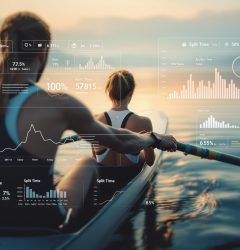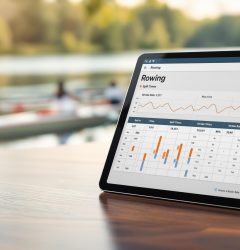04 Jan

Want to row smarter, not harder? Tracking the right metrics can transform your performance. From stroke rate to boat speed, these data points help you refine your technique, boost efficiency, and hit your goals. Here’s a quick breakdown:
- Stroke Rate (SPM): Measures strokes per minute. Adjust for warm-ups (20-24 SPM), endurance (24-26 SPM), or high intensity (26-30 SPM).
- Split Time (/500m): Tracks speed per 500m. Lower split times mean faster rowing.
- Heart Rate (HR): Stay in target zones (50-100% max HR) to balance intensity and recovery.
- Power Output (Watts): Measures energy per stroke. Aim for 55% of peak power during a 2K.
- Drive Length: Distance traveled per stroke. Optimize reach and technique.
- Force Application: Tracks how efficiently power is transferred during each stroke.
- Boat Speed (m/s): Combines all metrics to measure overall performance.
Using tools like Concept2, RP3, or ErgMonkey, you can analyze these metrics in real time and make data-driven improvements. Whether you’re training for a race or rowing recreationally, mastering these metrics is the key to better results.
The Complete Guide to the Concept 2 Monitor
1. Stroke Rate
Stroke rate, expressed in strokes per minute (SPM), plays a crucial role in rowing. It influences your power, workout intensity, and endurance. Essentially, it measures how many rowing cycles you complete in a minute, directly affecting your performance.
What Stroke Rate Tells You
For competitive 2K races, stroke rates typically range between 28-36 SPM. But keep in mind, rowing isn’t just about speed. Pulling harder with proper form is what truly boosts your efficiency [1].
How to Use Stroke Rate in Training
To get the most out of your training, align your stroke rate with the intensity of your workout:
- Warm-ups and endurance sessions: Aim for 20-24 SPM
- Standard workout pace: Stick to 24-26 SPM
- High-intensity intervals: Push it to 26-30 SPM
Modern rowing machines, like Concept2 and RP3, display real-time stroke rate feedback. This helps you fine-tune your rhythm and stay consistent throughout your session [1].
Improving Technique
A steady stroke pattern is key to efficient power delivery. Start by focusing on proper form at lower stroke rates. Gradually increase the rate as you improve, ensuring your technique stays sharp. This method not only enhances power but also helps avoid common mistakes [1][3].
Getting a handle on stroke rate is essential for controlling your pace. It also ties directly into split time, which we’ll cover next.
2. Split Time
Split time, shown as "/500m", measures how quickly you cover 500 meters while rowing. A lower split time means you’re moving faster and performing better.
What Split Time Tells You
Split time gives instant feedback on your pace and efficiency. Here’s how split times typically break down by experience level:
| Skill Level | 2000m Split Time Range |
|---|---|
| Competitive | Under 2:00/500m |
| Intermediate | 2:00-2:20/500m |
| Recreational | 2:20-2:40/500m |
How to Improve Your Split Time
To reduce your split time, concentrate on the drive phase – the part of the stroke where you push with your legs and pull with your arms. A stronger, more powerful drive means you cover more ground with each stroke, boosting your efficiency [4].
Using Split Time in Training
Split time is a great tool for tracking progress and setting workout goals. Use it to:
- Keep a steady pace during long, endurance-focused rows.
- Build strength and power by focusing on a strong drive phase.
- Set pacing targets for various workout intensities.
During a 2000m test, keeping an eye on your split time helps you manage your effort. It’s key to avoid starting too fast and burning out while still maintaining a solid pace [2].
While split time tracks your speed, pairing it with heart rate monitoring ensures you’re training at the right intensity for your fitness goals.
3. Heart Rate
Tracking your heart rate is a key way to manage training intensity and recovery in rowing. It helps you focus on rowing smarter, not just harder, by staying in the right zones for endurance, power, or recovery.
Heart Rate Zones Explained
| Zone | % Max HR | Purpose | Training Effect |
|---|---|---|---|
| Zone 1 | 50-60% | Recovery | Active rest, warm-up |
| Zone 2 | 60-70% | Base fitness | Builds endurance |
| Zone 3 | 70-80% | Tempo | Improves lactate threshold |
| Zone 4 | 80-90% | High intensity | Boosts VO2 max |
| Zone 5 | 90-100% | Sprint | Builds anaerobic power |
Using Heart Rate Data
Elite rowers often hit 160-180 BPM during intense intervals. Tools like ErgMonkey can help you analyze your heart rate zones to fine-tune your workout intensity.
Signs to Watch For
If your resting heart rate is higher than normal, your heart rate is unusually high for typical split times, or your recovery between intervals is slower, it could signal overtraining or fatigue. These are signs that you might need more rest.
Combining Metrics for Better Insights
Many rowers now use heart rate monitors that show real-time data alongside performance stats. Pairing heart rate with split times can reveal changes in your efficiency over time.
While heart rate reflects your internal effort, power output measures the external results of that effort. Together, they give you a fuller picture of your performance.
4. Power Output
Power output measures the energy you produce per stroke in watts (W). It plays a key role in determining your speed and efficiency, whether you’re on the water or using a rowing machine. Alongside stroke rate and split time, it’s a crucial metric for evaluating rowing performance.
What Power Output Tells You
Power output represents how efficiently you execute each stroke. It combines factors like force application, drive length, and stroke rate into a single, measurable value.
How to Develop Power Effectively
A helpful guideline is to aim for 55% of your 10-stroke peak power during a 2km row [3]. This benchmark helps assess how well you convert power into speed.
| Training Focus | Power Range | Purpose |
|---|---|---|
| Endurance | 60-70% max | Build aerobic capacity |
| Threshold | 75-85% max | Increase lactate tolerance |
| Peak Power | 90-100% max | Maximize output capacity |
Testing and Tracking Power
To monitor your progress, include power-focused tests like max-stroke tests, 10-second sprints, and endurance evaluations. Tools such as ErgMonkey can help you analyze trends and pinpoint areas for improvement.
Using Power in Real Time
Aim to maintain steady power throughout your stroke. This ensures efficient energy transfer and minimizes wasted effort during your rowing sessions.
Combining Metrics for Better Insights
Pairing power output with heart rate data gives a clearer picture of your overall performance. When combined with stroke rate and split time, these metrics offer a well-rounded view of your rowing efficiency.
While power output measures your energy production, drive length shows how effectively that energy is converted into movement. Together, these metrics provide a deeper understanding of your technique and performance.
sbb-itb-1725142
5. Drive Length
Drive length refers to the distance your seat travels from the catch to the finish during each stroke. It plays a key role in rowing technique, requiring a balance between reach and energy efficiency.
What Impacts Drive Length?
Drive length directly influences how effectively you row, balancing power output with energy use. To get the most out of your drive length, focus on aligning your technique with your physical capabilities and performance goals. Key aspects include:
- Maintaining a steady forward lean at the catch.
- Fully extending your legs to generate power.
- Keeping your core stable throughout the stroke.
Drive length works hand-in-hand with stroke rate and power output to help you achieve optimal performance.
| Race Type | Drive Length Focus | Purpose |
|---|---|---|
| Sprint Events | Longer drive | Maximize power generation |
| Distance Racing | Moderate drive | Conserve energy |
| Training Sessions | Variable drive | Improve technique |
Tracking and Adjusting Drive Length
Rowing machines like Concept2 and RP3 can measure drive length, along with power output and stroke rate. These metrics help you identify areas for improvement. Focus on these technical elements to fine-tune your drive length:
- Catch Position: Aim for proper reach without overextending.
- Drive Sequence: Coordinate legs, body, and arms smoothly.
- Recovery Phase: Maintain control as you return to the catch.
Since drive length varies between athletes, regular monitoring is essential. While it emphasizes stroke mechanics, pairing it with force application ensures you’re delivering quality power with every stroke.
6. Force Application
Force application goes beyond basic metrics like stroke rate. It measures how effectively power is transferred during each rowing stroke, separating raw effort from efficient technique.
Force Curves
Force curves on rowing machines display how power is distributed throughout a stroke. They help pinpoint inefficiencies. The goal is to achieve:
- A sharp rise in power at the catch
- A steady peak during the drive
- A gradual decline toward the finish
Force Application and Race Distance
Force application changes depending on the race distance:
- Sprints (500m): Focus on delivering explosive power.
- Mid-distance (2000m): Strike a balance between power and endurance.
- Long-distance (5000m or more): Emphasize steady and consistent power output.
Key Technical Skills
To optimize force application, work on these three core elements:
- Connection: Ensure firm and consistent contact with the handle.
- Sequencing: Engage your legs first, then your core, and finish with your arms.
- Power Transfer: Keep your core tight to maintain control and efficiency.
Training Tips
Integrate drills that target force application into your workouts. Machines like Concept2 and RP3 offer real-time feedback, making it easier to refine your technique and monitor progress. Regular evaluations can help you improve both technique and efficiency over time [3].
Mastering force application builds on proper drive length, ensuring every stroke delivers maximum power. This directly influences boat speed, which we’ll explore in the next section.
7. Boat Speed
Boat speed, measured in meters per second (m/s), is a clear indicator of your rowing performance. It combines technique, power, and efficiency, showing how well you’ve aligned stroke rate, split time, power output, drive length, and force application.
Improving Speed
Boosting boat speed means finding the right balance between stroke rate, power, and endurance. Stroke rates typically range from 26-36 SPM, depending on the race distance. Matching your stroke rate to the race length is crucial for maintaining both power and stamina.
Tracking Progress
Rowing machines like Concept2 and RP3 provide real-time boat speed data, including:
- Instantaneous speed
- Average speed per 500m
- Speed fluctuations during your session
These tools help you keep track of your performance and identify areas for improvement.
Efficiency Matters
Consistent speed with less energy use is the goal. Smooth acceleration, a clean recovery phase, and steady rhythm are key to maintaining speed without wasting effort.
Training Tips
Incorporate speed drills into your workouts to sharpen your performance. Pay attention to boat speed, heart rate, and power output to ensure you’re improving through better technique, not just brute force.
Video analysis and feedback from seasoned coaches can highlight technical adjustments that lead to better speed. By focusing on both technique and efficiency, rowers can see real gains in performance, tying together all the critical metrics.
Conclusion
Understanding and tracking these seven rowing metrics can make a big difference for athletes looking to boost their performance. Each metric offers valuable insights that, when combined, help create a smarter and more effective training plan.
Metrics like stroke rate, split time, heart rate, power output, drive length, force application, and boat speed work together to give a clear picture of rowing efficiency. For example, during a 5K, aim for a stroke rate of 26-30 SPM while keeping your heart rate in the target zone to maintain a good balance between power and technique.
Tools like ErgMonkey ($39.99/year) can provide detailed analytics to help you get the most out of these metrics. Focus on maintaining consistent form and efficient strokes, and use benchmark tests to monitor your progress. Progressing steadily across all metrics not only boosts performance but also helps lower the risk of injury.
FAQs
What are good rowing metrics?
Several key metrics come together to improve rowing performance. Stroke rates should match the type of workout – whether you’re focusing on endurance or sprinting. The goal is to strike the right balance based on your training objectives.
Heart rate zones are another important factor for effective training. Tools like ErgMonkey can analyze your performance across different intensity levels, helping you ensure you’re working at the right effort for your goals. This insight allows you to fine-tune your effort and technique.
When it comes to speed, it’s not just about increasing your stroke rate. Effective power transfer and proper technique are crucial [4]. This means:
- Keeping a steady and consistent form through every stroke
- Applying force efficiently during the drive phase
- Coordinating your movements for the best results

